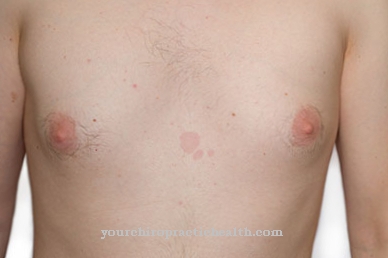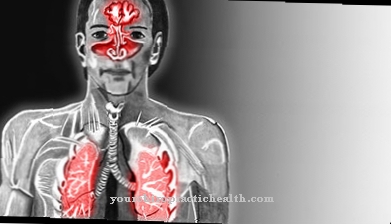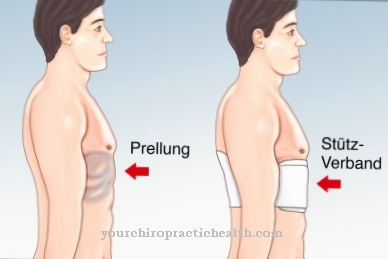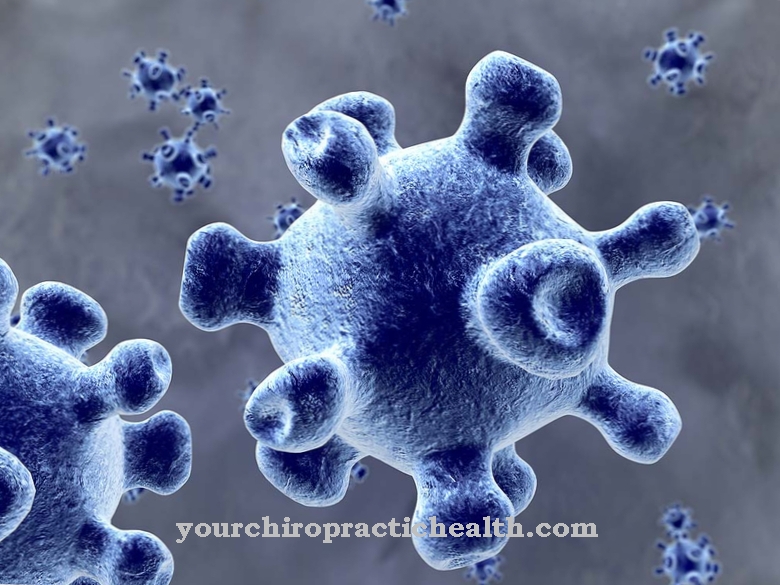When the immune system is weakened, the risk of contracting the human herpes virus type 8 increases, which is held responsible for the development of one Kaposi's sarcoma, a cancer that manifests itself as brown to bluish spots and tumors on the skin and mucous membranes.
What is Kaposi's sarcoma?

© RFBSIP - stock.adobe.com
In medicine one speaks of one Kaposi's sarcoma with a specific cancer. This does not occur exclusively but often in people who also suffer from AIDS. The cause of Kaposi's sarcoma is suspected to be the so-called human herpes virus type 8, also known as "HHV-8" for short, which, together with various cofactors, triggers the characteristics typical of Kaposi's sarcoma. Women are affected much less often than men.
causes
The formation of a Kaposi's sarcoma can only take place if the immune system of an affected person is massively weakened.
For this reason, Kaposi's sarcoma occurs particularly frequently in people who have become infected with the HI virus or who have already developed the immunodeficiency disease AIDS due to an HIV infection and were thus able to become infected with the human herpes virus type 8.
In addition to HIV or AIDS, other causes of Kaposi's sarcoma are also conceivable. People who have had an organ transplant are treated with immunosuppressive drugs so that their own immune system does not perceive the new organ as a foreign body and, as a result, reject it. For this reason, Kaposi's sarcomas often occur in transplant patients.
Symptoms, ailments & signs
Depending on its cause, Kaposi's sarcoma can cause different symptoms and ailments. In the classic form, light red, small spots develop on the skin and mucous membrane, which over time take on a brown-red to bluish color and develop into lumps. In the last stage, the nodules become encrusted, with severe itching.
The lumps can develop into ulcers, which increase the risk of infection. Accordingly, severe infections and skin changes often occur in the course of the disease. If the nodules are not treated, scars may remain. Permanent sensitivity disorders and symptoms of paralysis are also conceivable.
The nodes can be the size of a pin or the size of a palm and, in extreme cases, can spread to the internal organs. As a result, life-threatening internal bleeding can occur. Spreading to the internal organs can cause other symptoms, such as jaundice, liver disorders, inflammation and sepsis.
If Kaposi's sarcoma occurs as part of an HIV infection, the symptoms quickly increase in intensity and cause the person affected to feel very unwell. The nodules are accompanied by general symptoms such as fever, fatigue and fatigue. Usually Kaposi's sarcoma takes a severe course and significantly limits the quality of life of the person affected.
Diagnosis & course
The diagnosis can be made via the clinical picture, i.e. via visual characteristics, i.e. via the for that Kaposi's sarcoma typical visible abnormalities. These are brown-red to bluish spots that form on the skin and can range in size from the head of a pin to the palm of a hand.
A histological preparation can also be used to confirm the diagnosis. This is a tissue sample that is taken from the patient and then examined under a microscope. In order to distinguish whether Kaposi's sarcoma is the classic form or the form that occurs depending on the HIV virus, blood tests are also done to determine whether an infection with HIV is present.
As the disease progresses, painful lumps and ulcers develop from the spots. The mucous membranes in the mouth, intestines or genital area are particularly affected. In AIDS patients, spots often appear in high concentrations on the arms and legs. Without appropriate treatment measures, the spots and tumors will spread further. This often leads to metastases in the lymph nodes but also in other organs.
In patients who are not infected with the HIV virus, the lymphatic vessels can also be directly infested, from where the disease then spreads to the internal organs. In transplant patients, on the other hand, there are no external abnormalities when they have Kaposi's sarcoma. Instead, the internal organs are affected directly.
Complications
Kaposi's sarcoma usually results in the formation of a tumor. For this reason, the usual symptoms of tumor disease appear in this disease. In the worst case, this can also lead to the patient's death. Those affected suffer primarily from spots and lumps on the skin. These can be blue or purple and often lead to decreased self-esteem or inferiority complexes.
There are also various ailments in the stomach and intestines, with most patients also suffering from water retention. It is not uncommon for bleeding to occur on the skin that cannot be stopped easily. The tumor can also spread to other regions of the body and affect healthy tissue there. This may reduce the patient's life expectancy.
Treatment is usually done with the help of medication and surgery. This can lead to complications if the patient's immune system is already weakened by another disease. Under certain circumstances, the life expectancy of the person affected is reduced by Kaposi's sarcoma.
When should you go to the doctor?
If the typical symptoms of Kaposi syndrome are noticed, a doctor should be consulted the same day. Warning signs such as skin changes or gastrointestinal complaints require rapid clarification by a doctor in order to avoid complications. If ulcers or lumps have already formed from the spots, the affected person must see a doctor immediately. Patients who suffer from the symptoms mentioned in connection with a disease of the immune system are best advised to inform the responsible doctor. HIV and AIDS patients also belong to the risk groups and should have the warning signs clarified immediately.
If Karposi syndrome is not recognized, serious complications can develop. In the worst case, the metastases spread to other organs. Therefore, Karposi syndrome needs to be diagnosed and treated quickly. People who notice signs of illness should see their family doctor. Other contact persons are the dermatologist or an internist. Patients who experience the symptoms in connection with another illness should speak to their doctor.
Treatment & Therapy
Since that Kaposi's sarcoma Frequently occurs in patients whose immune system is already severely weakened, measures must be taken in the treatment of Kaposi's sarcoma that do not weaken the immune system even further.
For this reason, the so-called antiviral combination therapy, which is also used to treat the HI virus, is usually used in HIV and AIDS patients to treat Kaposi's sarcoma. The patients receive three different antiretroviral drugs, which are also abbreviated as ARV. The antiretroviral agents cause the symptoms of Kaposi's sarcoma to regress continuously.
In the case of transplant patients, too, care must be taken to ensure that the immune system is not weakened any further. Often, a change in immunosuppressive drugs already leads to Kaposi's sarcoma regressing.
In addition, depending on the patient, other therapeutic methods are often used to treat Kaposi's sarcoma. Local laser or radiation treatments as well as excisions or other physical therapies can also help in the early stages. In some cases, the use of chemotherapy is necessary for successful treatment of Kaposi's sarcoma.
You can find your medication here
➔ Medicines against redness and eczemaOutlook & forecast
With Kaposi-Sarlom, the person affected can support the medical treatment with a variety of self-carried out measures. The priority here is to relieve the weakened immune system and to weaken the effect of symptoms.
For this it is primarily important to avoid physically strenuous activities and rather to take care of rest or possibly even bed rest. Avoiding any stress is also absolutely essential, as it would weaken the body and also the immune system. On the other hand, it is helpful to change your diet in consultation with your doctor and a nutritionist. It not only supports the immune defense, but also has a preventive effect against symptoms such as water retention and can easily bring relief.
Additional measures can be taken depending on the individual symptoms. Various homeopathic ointments with ingredients such as calendula, belladonna, arnica or chamomile, which can be applied in consultation with the treating doctor, help with skin changes. Regular breathing training can help to prevent further cyanosis and thus an insufficient supply of oxygen. Depending on your doctor's advice, this can be done with or without a breathing trainer from the medical supply store and helps you breathe deeply and calmly. In addition, it has a stress-reducing, anxiety-relieving and relaxing effect on the body, which allows it to regenerate more quickly.
prevention
As a prevention against the classic form of the Kaposi's sarcoma A preventive vaccination against oncogenic viruses, which also include the human herpes virus type 8, is recommended.
Aftercare
In most cases, the patient of Kaposi's sarcoma has no special or direct follow-up options available, so that those affected with this disease are primarily dependent on a quick diagnosis and also on quick treatment. The earlier Kaposi's sarcoma is recognized and treated, the better the further course of this disease is usually.
In most cases, Kaposi's sarcoma is treated with medication. Those affected depend on regular intake and also on the correct dosage in order to relieve the symptoms correctly and, above all, permanently. In the case of children, parents must control the correct intake.
Furthermore, most patients are dependent on the help and support of family and friends, which can also prevent psychological upsets or depression. In the case of chemotherapy, loving conversations with close friends or with your own family also have a positive effect on the course of Kaposi's sarcoma. This disease can possibly lead to a reduced life expectancy of the person affected if Kaposi's sarcoma is detected late.
You can do that yourself
If Kaposi syndrome has been diagnosed, medical treatment is definitely required. The person affected can support the medical therapy through a number of self-help measures and resources from the household and nature.
The most important thing is a change in lifestyle. The already weakened immune system must not be further burdened, which is why strenuous physical activities should be avoided. A healthy and balanced diet strengthens the immune system and can prevent individual symptoms, such as water retention or skin bleeding. Avoiding stress is also important. If Kaposi syndrome occurs after a transplant, the instructions of the responsible doctor must be followed. In principle, rest and bed rest are indicated, supported by regular check-ups by a doctor.
Further self-help measures depend on the symptoms. Cyanosis can be prevented by breathing training. Ointments and creams from homeopathy, such as marigold ointment or preparations with chamomile, belladonna or arnica, help against skin changes. If these measures do not show any effects, the doctor must be consulted. In order to avoid a new outbreak of Kaposi syndrome, vaccination against oncogenic viruses should also take place.






.jpg)






.jpg)

.jpg)
.jpg)











.jpg)